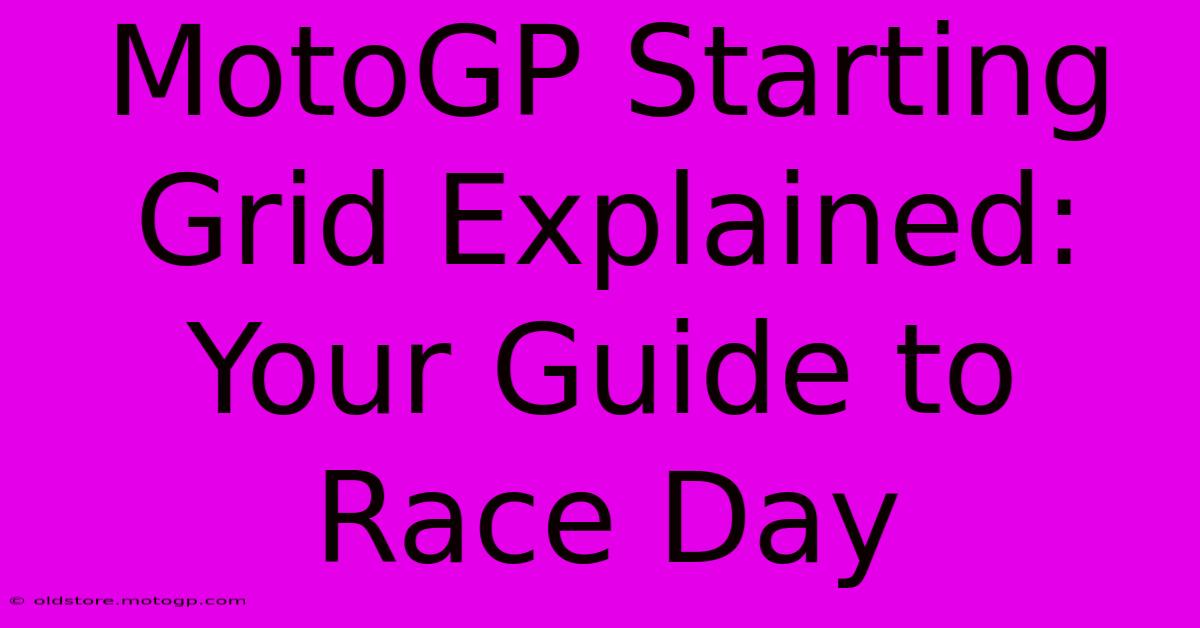MotoGP Starting Grid Explained: Your Guide To Race Day

Table of Contents
MotoGP Starting Grid Explained: Your Guide to Race Day
The roar of the engines, the smell of burning rubber, the heart-stopping acceleration… MotoGP race day is a spectacle unlike any other. But before the lights go out and the riders thunder down the track, there's a crucial element that often gets overlooked: the starting grid. Understanding the MotoGP starting grid is key to appreciating the race strategy and the drama that unfolds. This guide will break down everything you need to know.
How is the MotoGP Starting Grid Determined?
The MotoGP starting grid isn't random; it's meticulously determined through a series of qualifying sessions held throughout the weekend. These sessions are designed to showcase the riders' skill and their machines' performance. The fastest riders earn the best positions, leading to a captivating race day spectacle.
Qualifying 1 (Q1): The Fight for Q2
Not all riders start equal. Riders who don't finish within a certain timeframe during Free Practice (FP) sessions find themselves battling it out in Q1. This session is a high-stakes sprint, with only the two fastest riders earning a coveted spot in Q2. The pressure is immense; one mistake could mean starting further down the grid. This is where the real drama often begins.
Qualifying 2 (Q2): The Battle for Pole Position
The top 10 riders from the combined Free Practice times (including the two qualifiers from Q1) move on to Q2. This is where the true speed demons fight it out for pole position – the coveted first place on the grid. This is the most crucial qualifying session, determining the front row and setting the stage for the race. The rider with the fastest lap time earns pole, while the second and third-fastest riders claim the other spots on the front row.
Understanding the Grid Positions
The starting grid is arranged in rows of three, with the pole position (P1) located at the very front and center of the grid. Each subsequent position is numbered, with P1 being the best and the numbers increasing as you move down the grid. The position on the grid significantly impacts a rider's chances of success; a better starting position often translates to a better race outcome.
- Front Row (P1-P3): The prime real estate of the grid. These riders have the best chance of leading the pack into the first corner.
- Second Row (P4-P6): A strong starting position, allowing riders to fight for the lead early in the race.
- Third Row (P7-P9): Still a decent position, but riders will have to work harder to make their way to the front.
- Beyond the Third Row: Getting stuck further down the grid puts a rider at a considerable disadvantage, requiring aggressive overtaking maneuvers and often leading to more physical battles.
The Importance of the Starting Grid
The starting grid isn't just about position; it's a crucial factor impacting race strategy and outcomes. A good starting position offers:
- Clean Launch: A cleaner start without traffic congestion, allowing for optimal acceleration.
- Track Position: A better chance of leading into the first corner and controlling the race pace.
- Strategic Advantages: The ability to dictate race strategy and block rival riders.
However, a poor starting position isn't necessarily a death sentence. Many riders have proven their ability to overcome a less-than-ideal starting grid position through skillful riding and clever overtaking. The race itself remains a test of skill, strategy, and endurance.
Beyond the Grid: Other Factors Influencing the Race
While the starting grid is vital, it's not the only factor influencing the race outcome. Other elements include:
- Tire Choice: The selection of tires impacts grip and performance throughout the race.
- Race Strategy: Fuel management, tire wear, and overtaking tactics all play a crucial role.
- Weather Conditions: Unexpected changes in weather can dramatically alter the race dynamic.
- Rider Skill and Machine Performance: These are the fundamental ingredients determining the ultimate outcome.
Understanding the MotoGP starting grid is essential for appreciating the nuances of the race. It highlights the importance of qualifying sessions, the strategic implications of each position, and the thrilling battles that unfold even before the race begins. So next time you watch a MotoGP race, remember the effort and precision that went into determining the starting grid – the foundation of the incredible spectacle to come.

Thank you for visiting our website wich cover about MotoGP Starting Grid Explained: Your Guide To Race Day. We hope the information provided has been useful to you. Feel free to contact us if you have any questions or need further assistance. See you next time and dont miss to bookmark.
Featured Posts
-
Cota Circuit Days The Ultimate Driving Adventure
Feb 24, 2025
-
The Art Of Scoring In Moto Gp Points System Explained
Feb 24, 2025
-
Moto Gp Sprint Race An Epic Contest Of Speed
Feb 24, 2025
-
Lub Si Cota And Meditation Enhancing Your Practice
Feb 24, 2025
-
Unleash Your Inner Racer Own A Moto Gp Legend
Feb 24, 2025
